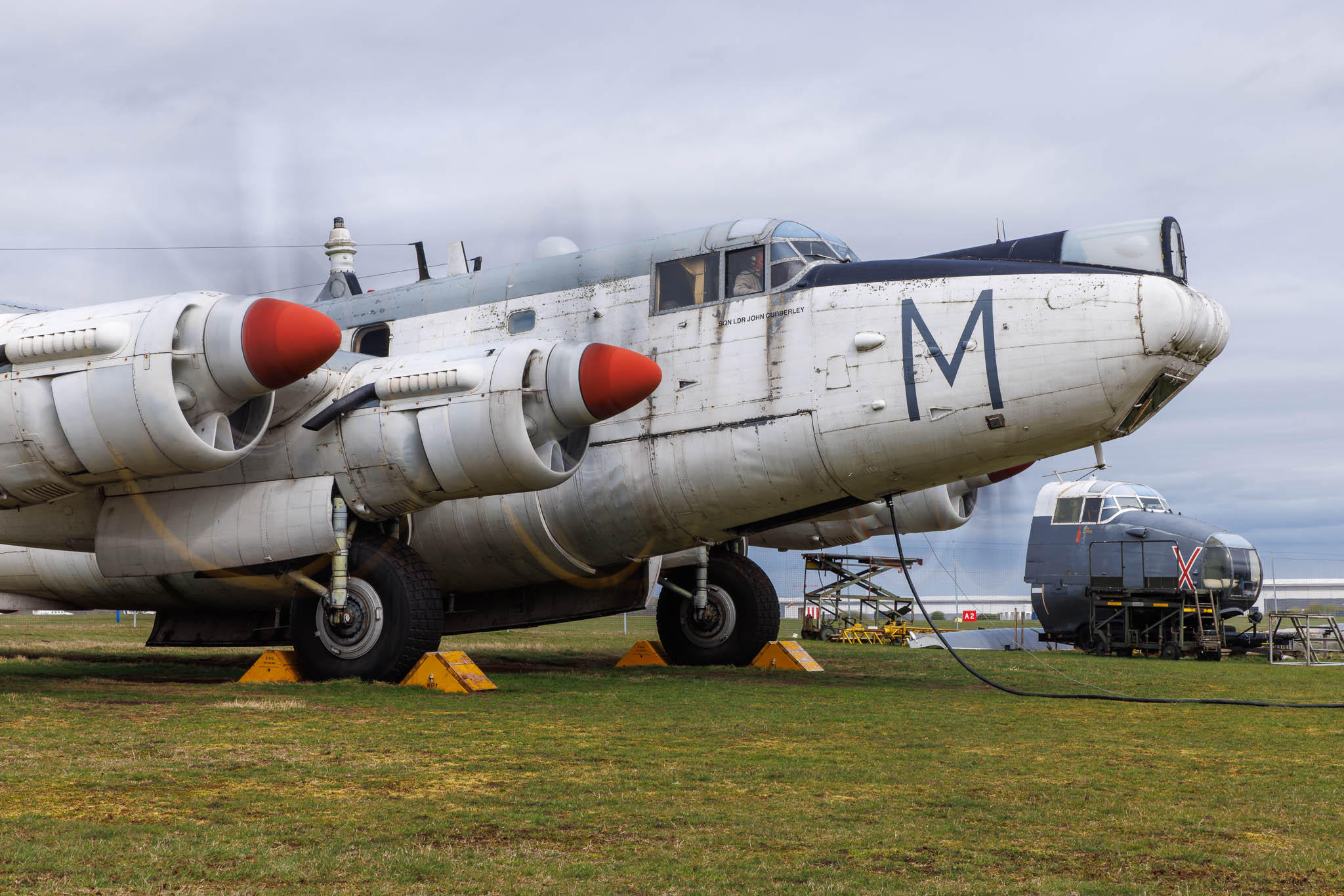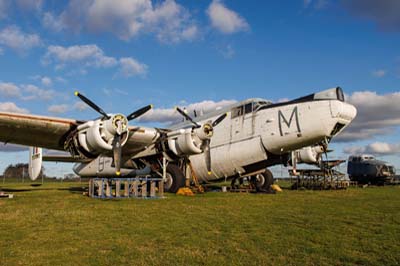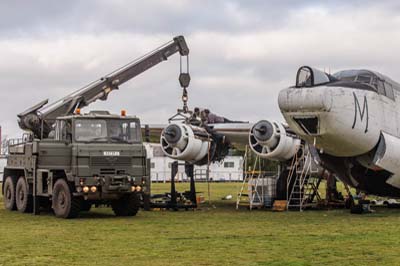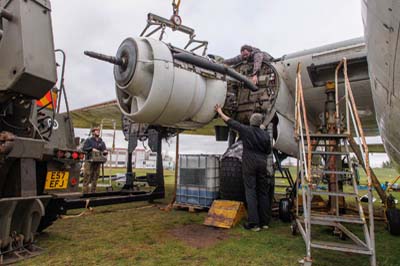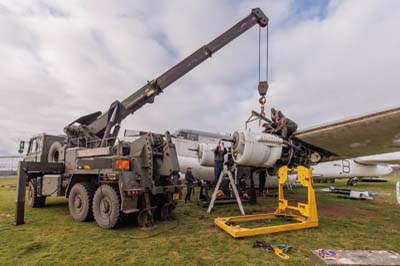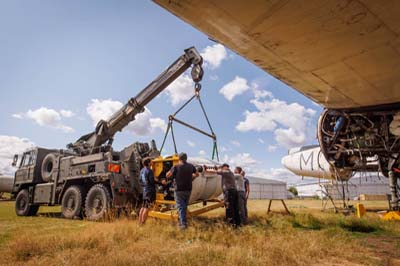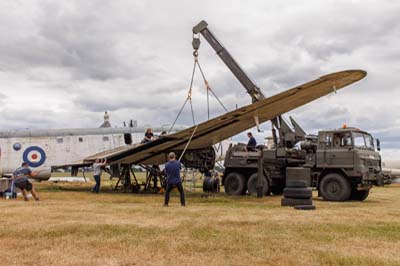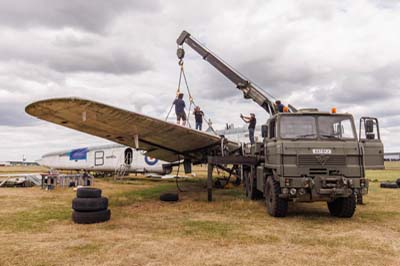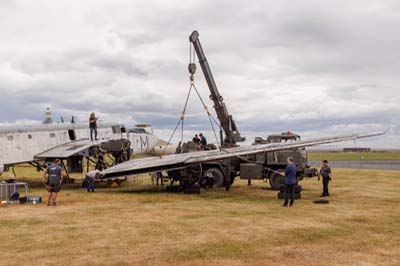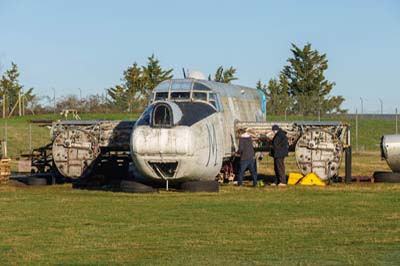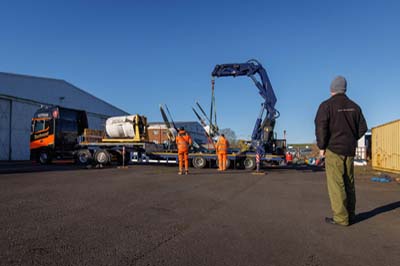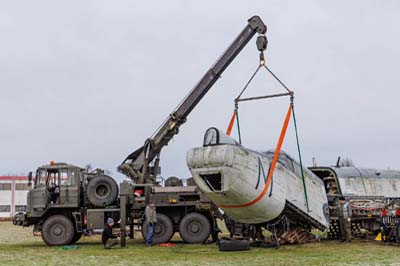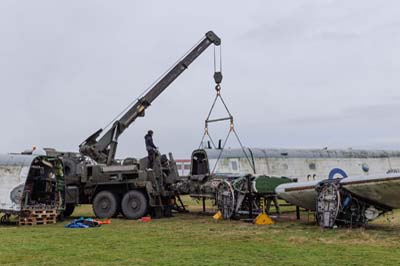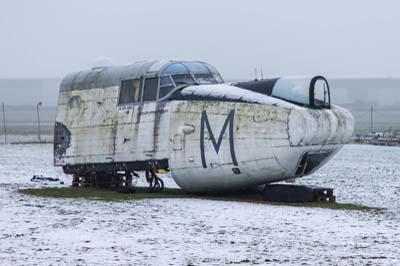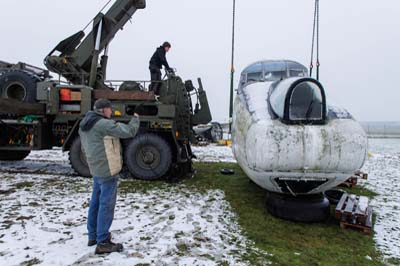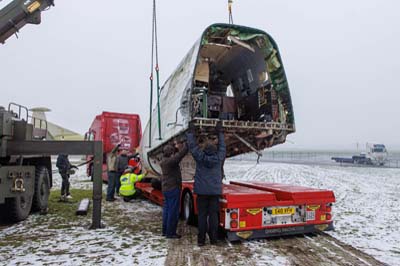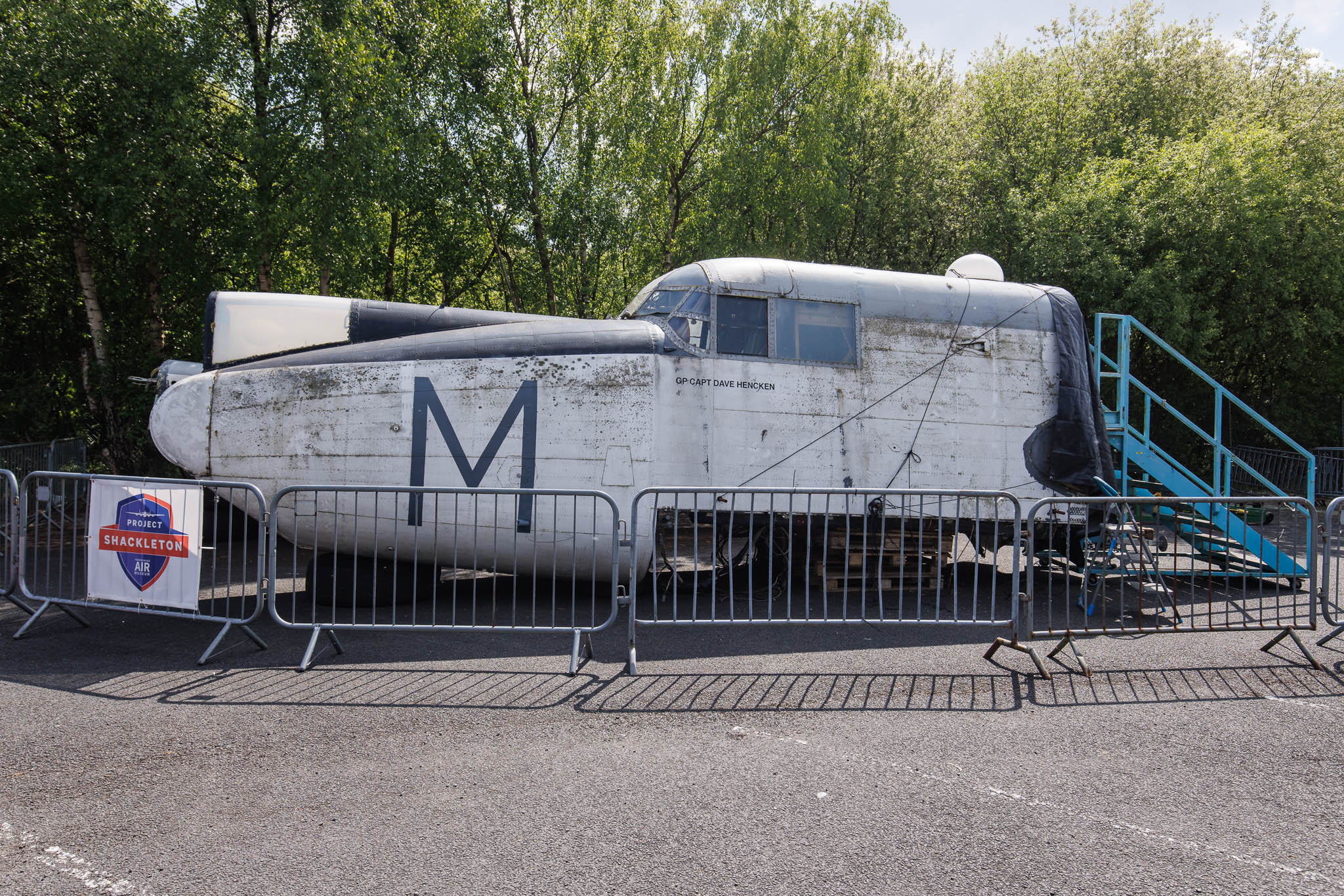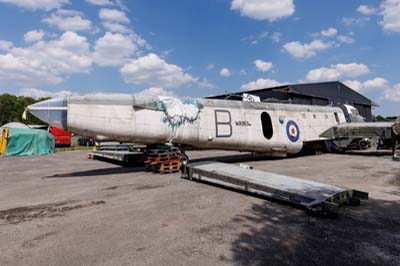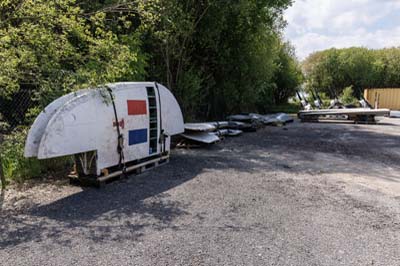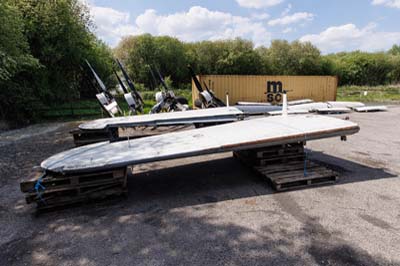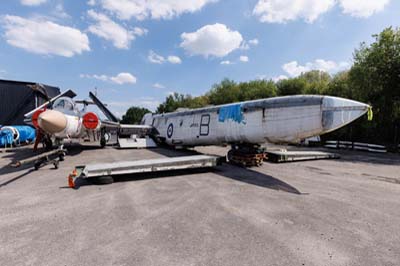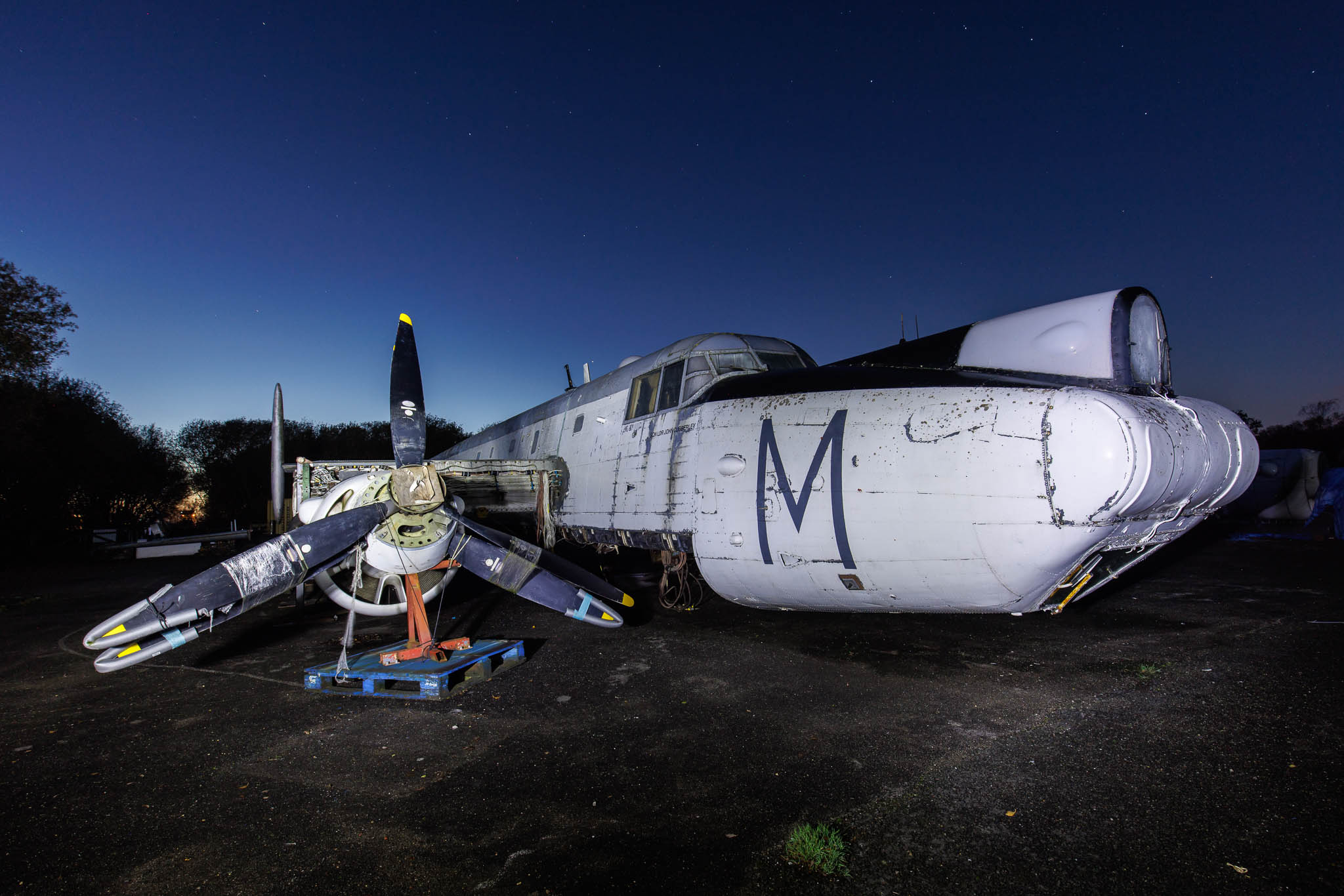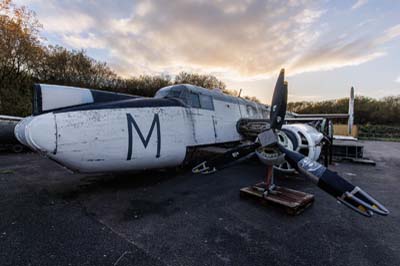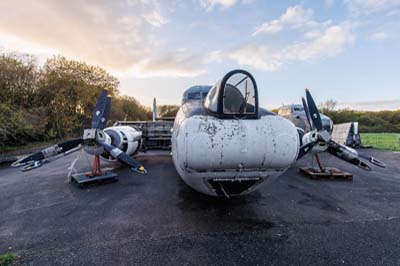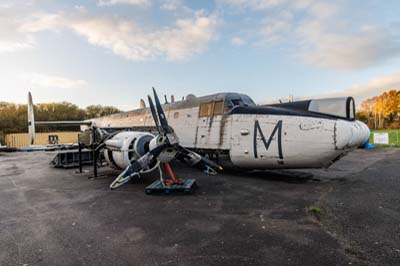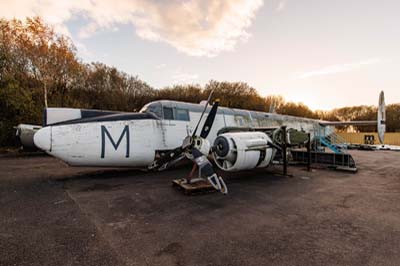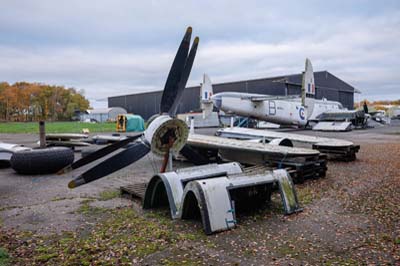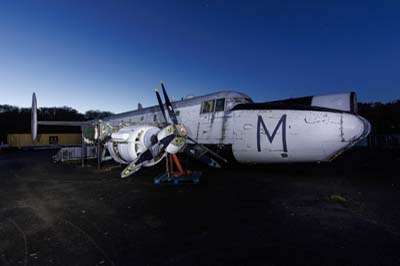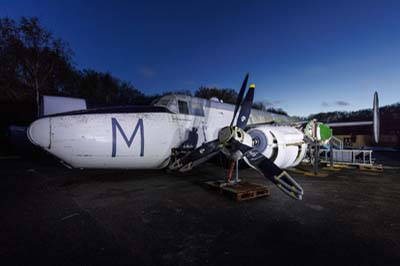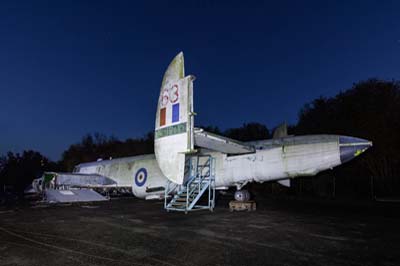Shackleton WR963 - Richard Woods
Shackleton Aviation Group
Coventry - Bagington airport
The move from Coventry to Elvington - April 2023 to January 2025 and beyond...
|
| April 2023: The last engine run before WR963 is dismantled. The Rolls Royce V12 supercharged Griffon engines hitting just under 2,400 RPM, I was told! All four engines ran without a hitch on this anti-det run, the second objective was to burn surplus fuel before the big move to Elvington. In the background is the cockpit section of Avro Shackleton T.4 (VP293 'X') named 'Zebedee' it was the first piece to move to the Yorkshire Air Museum in December 2023. VP293 was once with the Strathallen Collection before it closed and the remainder of the aircraft was scrapped. |
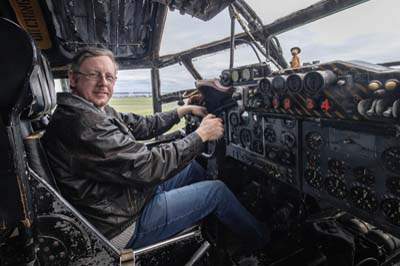 |
Richard Woods at the controls of the Shackleton. |
My exclusive cockpit interview with Richard Woods back in April 2023
At this time Richard was just beginning to put his plan together to move the Shackleton to Elvington. Almost two years later the move was complete. Later in 2025 all the disassembled parts had to be put together again and the aircraft restored to engine-running order, but that's another story. I followed the project from this point until the move was complete. What follows is an unedited exclusive interview with the move project leader. More or less what Richard's plan was carried out more or less as he anticipated with one exception, he thought it would be complete by September 2023, it would be completed January 2025.
Richard, how did you get involved with this project?
I came down to Coventry in 2000 for a Dakota flight with Air Atlantique who were doing passenger flights. That's when I saw the Shackleton with a bunch of guys working on it I climbed on board and introduce myself and they let me have the run of the aircraft, as we now do with our visitors. I did not want to leave. As I was living in Chesterfield 90 miles from Coventry, I just kept in contact by email. Around 2008 or 2009 I now had the transport and financial means to come down here on a weekly basis and help look after the aircraft along with them. I basically have been here ever since. I have a mechanical background my hobbies have been restoring old cars. I was a Royal Engineer in the British Army before moving to the Civil Service. I did apply to fly with the RAF but failed the medical.
|
Left to right: November 2023: Panels and some of the propellers have now been removed.
December 2023: The Rolls-Royce Griffon engines were removed and lowered on to an engine stand using a Foden S106 6x6 Recovery vehicle was fitted with a lifting beam, owned and operated by Mark and James Worrall. The two ton Griffon engine is held in place with four bushes, tapered pins and bolts which have to be removed once the Foden has taken the weight. Richard Woods has many contacts in the aviation field who generously offer help advice and equipment. The engine stands came from Lincolnshire Aviation Heritage Centre at East Kirkby and the lifting beam from the Royal Navy Historic Flight. The 35 year old Foden was one of 333 delivered to the British Army between 1986 and 2002.
January 2024: Another weekend with Avro Shackleton team, this time to detach the remaining two engines on the port wing. The starboard stabliser which had been reluctant to seperate was also removed. The Rolls-Royce Griffon engines were removed and lowered on to an engine stand using a Foden S106 6x6 Recovery vehicle fitted with a lifting beam. Still a lot of work to be done by the team.
|
 |
| February 2024: This weekend with the Avro Shackleton team with the engines removed are now disconnecting wires and piping. This is in readiness to removing the bolts for the wings and fuselage. Internally, some of the cabin systems also need to be removed to gain access to some of the fuselage bolts. |
Left to right: July 2024: Team Leader Richard Woods with Dave Baylis and their crew of volunteers are another stage further to dismantling their Shackleton WR963 ready for its move to Elvington. The four Griffon engines were carried to the adjacent temporary storage area ready for the low loaders, hopefully in a few weeks time.
Today it was the wings that were to be removed, held by four pins which have held the wings on tightly secured for decades. They had to be knocked out while the Foden crane took the weight. It was not sure what the wings would do in the slight breeze once the last pin was removed. With cries of "Brace Yourself Rodney" [Only Fools and Horses] the port wing fell free and with the careful planning combined with slight adjustment of tensions the actual moment was not as dramatic as some may have thought. The wing swung a little as it was lowered onto tyres, drama free. The starboard wing was more of a problem, a pin would not release and the wing was still in place at the end of the day. The port horizontal stabiliser also was tackled, but it stubbornly refused to yield.
|
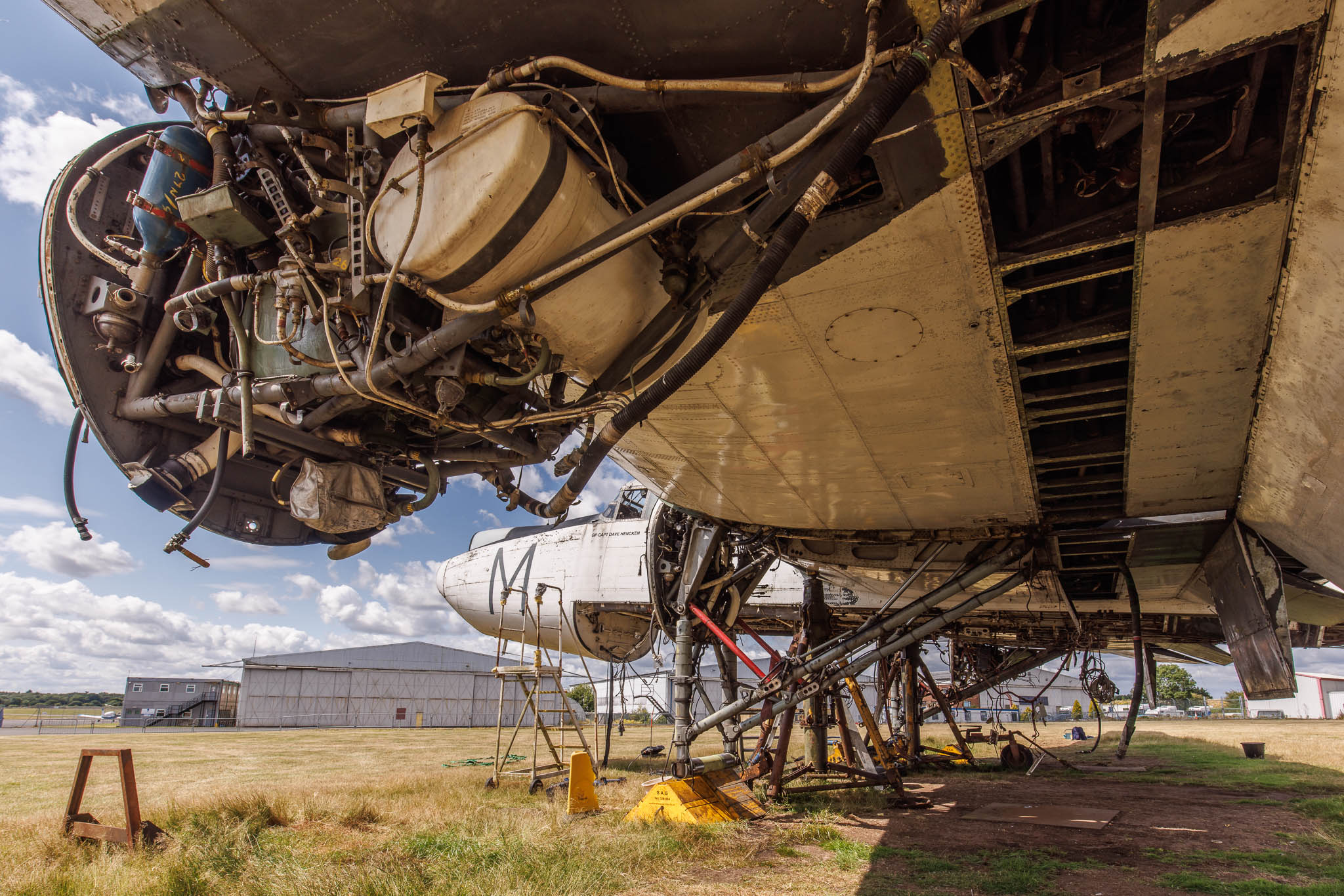 |
| July 2024: A sad sight, with all the hanging wires (all documented) and the wheels removed. |
I made him a promise.
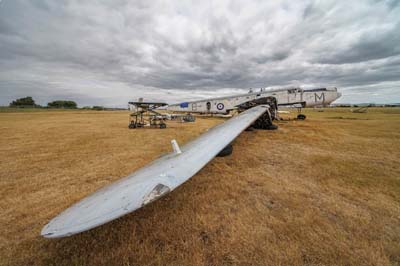 |
August 2024: After a prolonged period of documenting and disconnecting wiring WR963 is lowered to the ground. |
The guys looking after the Shackleton were all ex-Shackleton groundcrew and aircrew they were very thorough in teaching us that we were the next generation to look after the aircraft maintain and run it so that it can stay live for the longest time possible. I didn't know at the time, but they were looking forward even then for people to look after the aircraft to preserve it in an engine running condition. The projects leader since 1998 was Squadron Leader (retired) John Cubberley, he passed away in 2019. I had made him a promise and before his last visit that I would try and keep the aircraft engine running for as long as possible. Going forward I love to see it fly again but that would take millions in the interim just keeping it preserved in engine running condition so people can hear it smell it as it was back then, that's the priority.
The planned move to the Yorkshire Air Museum at Elvington, Yorkshire.
What we're encountering now is the drawdown of Coventry Airport with planning permission for a factory which will mean an end to all aviation activities here, so we had to look for another preservation environment where we could continue to run the aircraft Elvington fitted that bill very well. They can run some of their own aircraft up and they have access to a long runway. I had a meeting with the guys at Elvington to come up with a plan to get WR963 up there. As part of the planning, we've been looking deep into the manuals also in recent times have been three or four Shackleton that have been moved to other locations. We have looked to see what they learned about that process for some of the things we will have to encounter is that the aircraft's wiring is almost a single wiring loom in the fuselage so in splitting the fuselage for the move we have to either back-feed all the wiring or find a way where we can attempt to cut it and re-join it which is something I really don't look forward to.
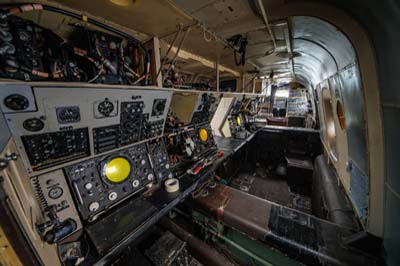 |
The inside of the Shackleton is packed full of original maritime/AEW electronic equipment which has to be moved. |
Mechanically the plane is very simple to dismantle which is a legacy of its Lancaster heritage. The sections it breaks down to are very small fairly small so standard haulage companies can move the aircraft easily as the weights are fairly small for each component. There will be quite a few loads including engines, outer wings, tail, and fuselage sections it seems very simple, but it will be a lengthy task to complete the move. Currently we are in the final stages of planning with the haulage companies Costs have increased due especially to fuel pricing, but we are on target now to move in September [2023] which was agreed with Elvington as they have various events running through the summer, which we don't want to interrupt. When you take into account engineer's costs, craneage and haulage it will cost over £60,000 all in.
We intend to move a running aircraft at Coventry and take it to Elvington and still have it engine running which makes the move more expensive. If we did it with more haste and did not intend to engine run at Elvington then we could cut costs and time for the dismantling of the aircraft and its systems, you would have a physical aircraft at the other end, but it would never run again. Elvington are looking forward to seeing a running aircraft up there as much as we are. Elvington gives us security in the long-term. They own their site through the trustees who bought their site some years ago. Bottom line we are looking to preserve the aircraft for as long as we can. The current team consists of serving and ex-RAF personnel, ex-Shackleton Squadron groundcrew.
Do you have all the skills you need?
We cooperate with other Shackleton and Lancaster groups worldwide to share information, drawings, and spares. We are not short of expertise out there. I know where I can go if I have a problem with an engine or airframe issue. I'm also asked if I have some spare parts or some drawings to help other Shackleton preservation groups this includes the Lancaster preservation group at East Kirkby who asked us if we had drawings for the fuel tanks bays where the fuel tanks bottom skins meet the spa booms. As there is a lot of commonalities between the Lancaster and the Shackleton in the Avro bomber's world we all tend to talk to each other, we have to, it's mutual survival for all of us.
We are still missing some skills such as structures were sitting on grass we are always combating corrosion. Sat here on the grass we're not really set up to do massive repairs to the skin sections, which is something we may particularly need when we get up to Elvington. At Elvington they have already created a great skill set from nothing when they restored their Halifax using the wings from a Hastings which was a phenomenal achievement.
|
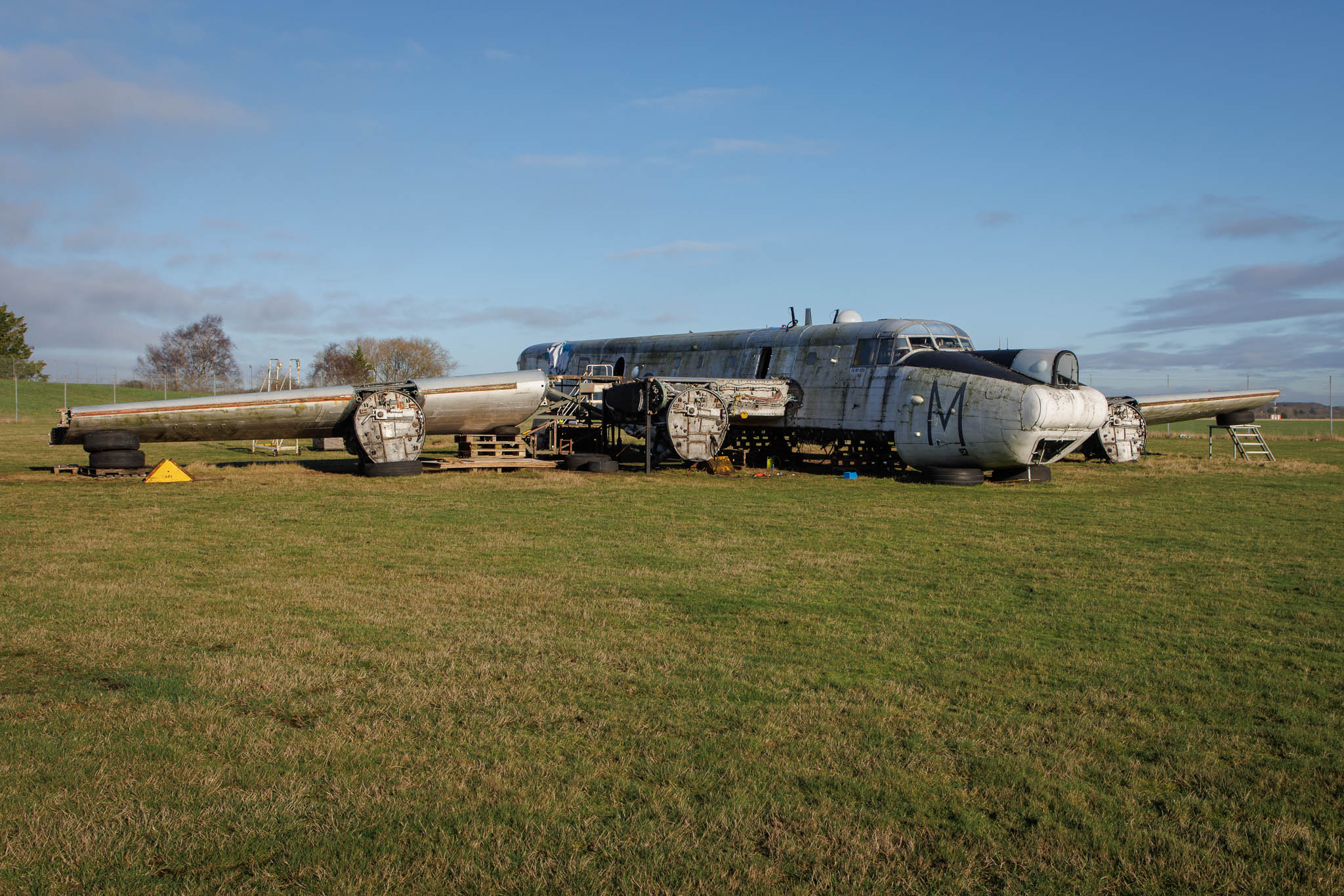 |
| January 2025: WR963 has been resting on its belly for quite some weeks now, three of the engines and other small sections have travelled north to Elvington. The Shackleton's move to its new, safe and secure home, the Yorkshire Air Museum at Elvington, Yorkshire. The final push, managed by Richard Woods, took three long and exhausting days, one sunny, one overcast and one snowy. Each day involved a crane, notably the former British Army Foden and two flatbed trucks shuttling daily back and forth between Coventry and Elvington. The final Griffon engine, four propellors and the Shackleton, split into manageable pieces were all hauled onto their road transport, guided by Shackleton volunteers and secured using straps, pallets and Dakota tyres for the journey north.
|
Will the Shackleton fly again?
We had lofty aims when we set up things in 2012 with a new team. Since we've been here we got the aircraft registered on the civil register we got the type accepted with a permit to fly. The long-standing spar boom issues always raises its head. British Aerospace at the end of the Shackleton's RAF service insisted that the type was life expired due to the spa boom and various other components and they wouldn't move at all. The civil aviation authority correctly took that line saying that British Aerospace own the Shackleton type. In 1993 British Aerospace sold the design rights and manufacturers drawings archive to the Shackleton Preservation Trust. We inherited this paperwork which suggested that the situation was not as clear-cut as first thought. In 2012 we proved that the spar boom was not life expired. Looking at WR963's history we found that there were 594 hours left on the components within the wing spars. The problem now is with 30 years standing outdoors we don't think we can trust the wing to safely fly the aircraft without the extensive rebuild they wanted in 1991.
Flying WR963 is still a dream, if someone should turn up with a lottery win we would be ready to get things moving. Until that time, I am happy to see the aircraft taxiing on the ground, the last time being five years ago. I want to see it move under its own power before we take it apart. Apart from a leaking brake on the port main wheel and some airport-imposed conditions through getting the aircraft safely off the grass and onto the taxiway there is not a capable tug on site which we need, as we are on a very small incline. If we got her off we may not be able to get her back on again and so be in everybody's way. The last time we taxied we went out twice with paying people on board and outside and it was very successful. Elvington has a short strip of tarmac to the runway, and they have tugs to pull the aircraft. So, we hope they can return to having ground running and taxiing days.
|
Left to right: January 2025: The last fixing points for the lifting straps are being fitted so that the cockpit section can be lifted and moved.
Richard Woods is supervising the loading of the last Griffon engine and three of the four propellors, which is all this flatbed truck can load.
The nose has been detached with a minimum of wiring cut so that it can be lifted clear, ready for its move tomorrow. Supervising the lift is Richard Woods, Mark Worrall (Foden) and Graham Buckle (Yorkshire Air Museum).
Detached next is the centre section containing the main spar and wing roots. Each section was designed to e detached easily for transport from the factory. The early wiring was all fitted with connectors to allow seperation without wiring cutting. However when WR963 was converted from MR.2 (Maritime Reconnaisance) to AEW.2 (Airborne Early Warning) standard in 1971, the additional wiring was not fitted with connectors across the fuselage joints and now had to be cut. James Worrall is on the Foden taking the strain.
|
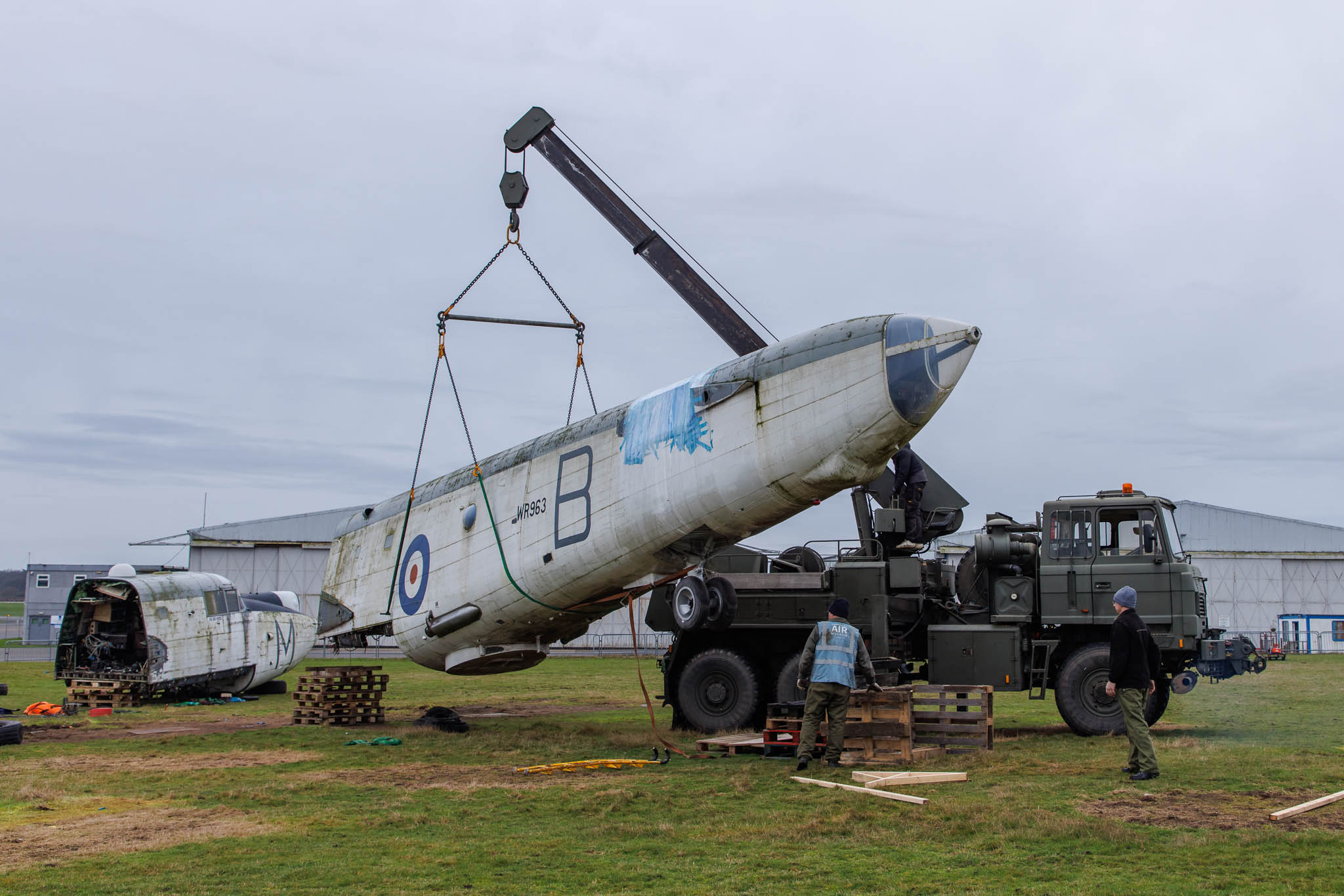 |
| The rear fuselage was the longest section weighing four tons it was easily lifted by the mighty Foden. L & KR Thorpe Transport's flatbed truck had to be extended to cover its length. Yorkshire Air Museum provided a support vehicle to escort the two truck convoy up the M69 and M1 and on to Elvington. They arrived in the dark just before the Police approved transport permit expired for the day. |
| The Shackleton's nose was the last to leave the site where it had been at Coventry since its retirement in 1991. Mark Worrall and his son James team up with their Foden to lift the nose. |
Raising funds
Most of our fundraising is online through the website with membership. People on the gate do help by paying to see our engine runs but most of the money however comes from business sponsors and suppliers. We also had a welcome boost from the Covid relief fund. Up to COVID-19 we had quite good finances but were not able to get to the aircraft for 18 months.
The cost of the move is funded by sponsorship from the crane company and haulage company for the smaller items such as the tail fins and engines. We are also looking for sponsorship for the larger items such as the fuselage sections and outer wings. 90% of our funds comes from sponsorship we look at original equipment manufacturers like Dunlop, British Aerospace and Meggitt Aerospace. British Aerospace still supports the Lancaster, it's not impossible that they will feel charitable in the future to support the Shackleton.
The Directors within the Shackleton Aviation Group help to find sponsors, my specialty is chasing for parts and information on the mechanical side of things. Phil Cain is very good on the sponsorship and funding, Sam Thompson who is serving RAF, he looks at things from a forces point of view for sponsorship and cooperation from the RAF who are keen in looking after their heritage today.
|
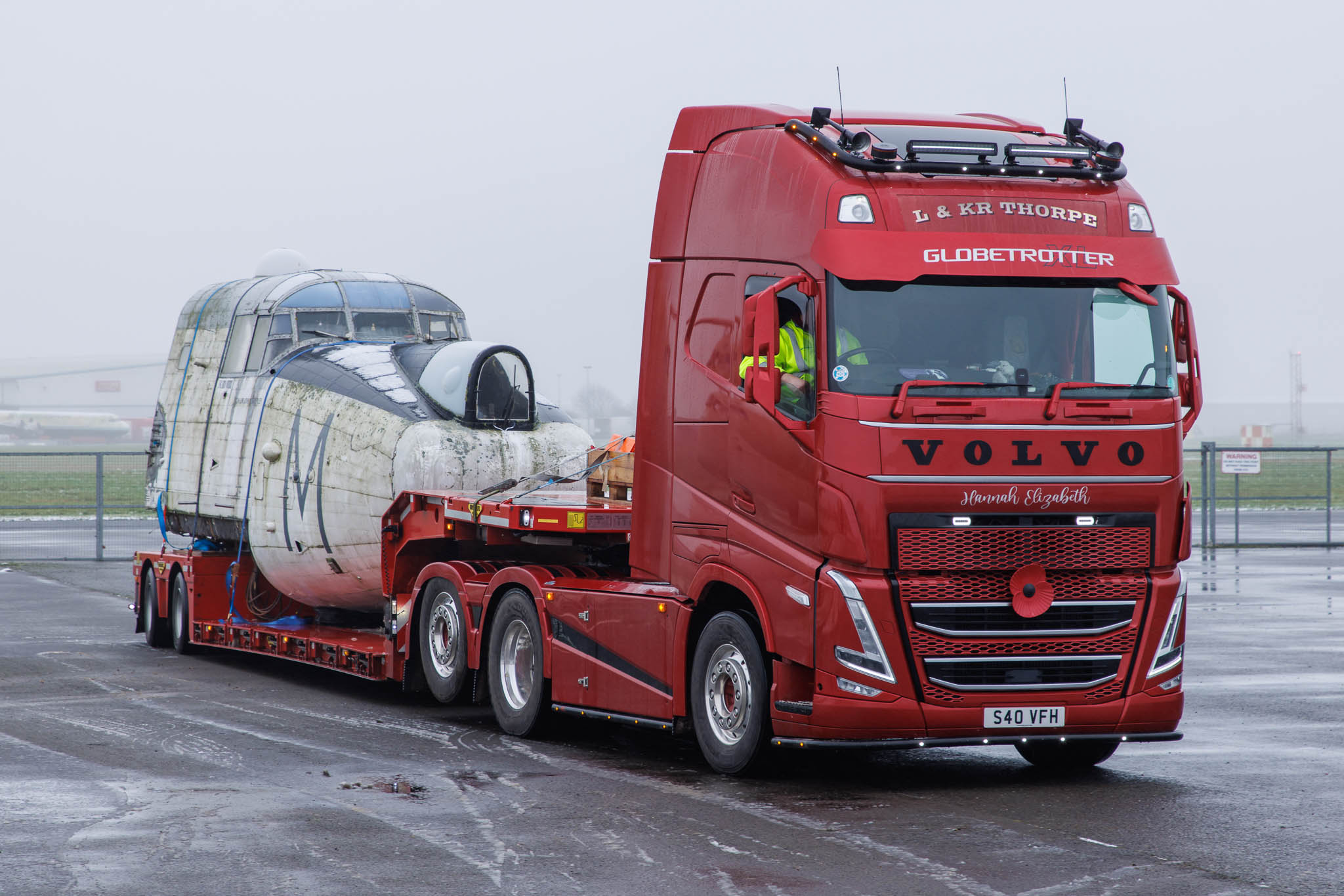 |
| The Shackleton's nose is ready for the journey north to Elvington. The Shackleton's move took longer than originally planned for all sorts of logistical reasons, the process starting more than two years ago, which unfortunately necessitated extensions to the ground rent lease at Coventry Airport with further expense. This and the large haulage costs has all been funded by donations. The project will still require additional donations if the Shackleton is to be restored back to engine-running order and display. |
| Yorkshire Air Museum, Elvington |
| Left to right: May 2025: The process of putting WR963 back together began in March. A few days after my visit on May 17 the cockpit section was reconnected.
|
Left to right: November 2025: Two engines were reattached to the wings while the fuselage was still supported by the fabricated stands. An aircraft engineer with 50 years of experience questioned this approach, asking, "Wouldn’t it have been easier to set it on its main undercarriage first? You’re now going to need a bigger crane!"
Richard Woods replied, "We’d need the two cranes we plan to use to lift her regardless of whether the engines are fitted. Aligning the engines on the firewalls was easier with the firewalls vertical."
|
